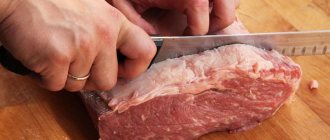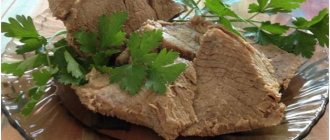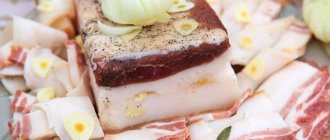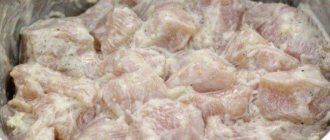Fresh meat does not always have a pleasant smell. Odor appears for a number of reasons: improper slaughter, storage, etc. How to get rid of the smell from meat? Firstly, a rotten product should be thrown away immediately if you don’t want to get poisoned. After the procedures we suggested, slightly spoiled fillets or ribs will turn out to be quite a flavorful dish. The article also contains tips on eliminating the specific smell of lamb, pork boar, and goat meat.
Get rid of the rotten meat smell in the refrigerator
Why does meat go rotten even when it is in the refrigerator? This occurs due to improper storage. The fact is that the plastic bag in which we usually place the carcass provokes the appearance of a strange aroma even before the product goes rotten. To get rid of the rotten smell of meat that has been stored in the refrigerator, there is a proven method.
- vinegar,
- soda,
- tea bags.
- Defrost the refrigerator.
- Wash with detergent.
- Apply baking soda to a piece of cloth and wipe the areas where the rotten meat was.
- If the smell persists, clean the refrigerator with a vinegar solution.
- Ventilate the room and refrigerator.
- Place tea bags inside (they absorb odors) and turn on.
Causes of unpleasant pork odor
The first thing a cook might think about is that the purchased meat turned out to be stale or has spoiled due to improper storage. This option is possible, but it is not the only one. Sniff the pieces that have not yet been heat-treated; perhaps there is a “fragrance” from them too, just heating made it more obvious.
It happens that raw meat looks and smells absolutely perfect, and the amber appears only when heated. It does not matter which cooking method is chosen: boiling, frying or baking. In this case, we hasten to disappoint you, the purchased pork is the meat of a knur (boar) - a wild boar that has not undergone the castration procedure. Now you have to solve the problem of how to remove the smell of boar from pork meat to make it edible.
Causes of odor:
- Entire. The hormone testosterone, which is produced by the body of a sexually mature animal, leads to the accumulation in the muscle tissue of a substance called skatole, which is the source of the foul odor.
- Congenital developmental anomalies. It happens that one testicle in a wild boar does not descend into the scrotum and remains inside the abdominal cavity. In addition, as a result of developmental abnormalities, the animal may have three testicles, one of which also remains inside. In this case, after the castration procedure, testosterone continues to be produced, and after slaughter and cooking, the meat will acquire a specific smell.
If you buy boar meat from farmers you know, whether you can eat it without the risk of stinking up the whole apartment during cooking depends on the age of the animal. Buy piglets up to six months without fear, but adult sires should be castrated a couple of months before slaughter.
photo from the site https://animal-photos.ru/
The easiest way to get rid of the smell of boar pork is not to buy such meat. Theoretically, a boar should not even get on the counter, since his meat will not pass certification, but in practice this does not happen so rarely. But how to avoid a mistake, because it cannot be recognized until heat treatment, and even purchasing from conscientious livestock breeders cannot always protect it. To do this, before purchasing, ask the seller to check the selected piece in one of the following ways:
- Light a small piece with a lighter, trust me, you won't be able to miss the pungent amber.
- If the seller does not want to cut off a piece for testing, pierce the pork with a knitting needle or needle heated over a lighter, the effect will be the same. Of course, take sharp objects from home.
photo from ru.wikipedia.org
The smell of lamb, boar or goat
Lamb is the favorite meat of Eastern nationalities, but Europeans do not always like its specific smell, even when fresh. The following measures will help eliminate meat odor.
Method 1. Take dried thyme - 2 sprigs.
What should be done:
- At the very beginning of cooking, add a couple of sprigs of thyme to the water.
- The smell of lamb will go away during cooking.
Method 2. Take:
- garlic,
- spices.
What should be done:
- Rub the lamb with spices and garlic.
- Leave in the refrigerator for at least 2 hours.
Method 3. Take water and a saucepan.
What should be done:
- Pour water over the lamb and bring to a boil.
- Drain the water.
- Repeat 3-4 times. The smell should go away along with the water.
Advice! You can notice fatty patches on the ram. They are the ones who create the scent that not all housewives like. Cut these parts off and there will be virtually no smell left.
The smell of goat is also not for everyone. Soaking it in a solution of potassium permanganate (the method described above) will eliminate it. Another option is vinegar. Prepare the solution, immerse it or simply pour it over the goat meat pieces.
Boar meat is prohibited for sale, but if you are careless, you can purchase this product with a terrible smell. No amount of spices will cover it. The only way to eliminate the stink is to soak finely chopped fillets in milk for at least 10 hours. In this case, you need to replace the milk with fresh milk every 2 hours.
Slightly rotten smell
If left in a warm room even for a short period of time, various microbes and bacteria will happily get to work, receiving a nutrient medium in the form of an appetizing cut of meat.
The smell appears very quickly. You can remove it using the following methods.
- Soak in cold water with a spoonful of vinegar for an hour, then rinse.
- Soak in lemon juice or wine for an hour. If the piece is large, it should be cut into pieces. After this, rinse.
- Spread small pieces in mustard and leave for an hour. After this, rinse thoroughly.
- Soak in salt water (there should be a lot of salt), then rinse thoroughly.
- Soak in a weak, barely pink solution of potassium permanganate, then rinse in running water and leave in cold for 15 minutes.
- Chop onion and garlic into a container with meat, add herbs and leave for an hour.
If during this time the desired effect does not occur, the meat can be considered completely spoiled. In addition, if the smell returns during cooking, you should not waste the effort and money spent - you must throw away the product immediately.
We recommend: Can Grandma's china be washed in the dishwasher?
Recommendations
These tips will save you from mistakes in buying, storing and cooking meat.
- If the piece is large, cut it into pieces before processing.
- If the smell still remains, then throw away the product - it is completely rotten.
- In order not to make a mistake when purchasing and to purchase a product without foreign odors, always pay attention to the color: it should be even. Other signs of a good product are elasticity and a neutral aroma. If the fillet has a strong smell, you should refuse to buy it: this is a sign of a stale product or harmful additives.
- Store meat parts in the refrigerator, or better yet, in the freezer. Wrap them in parchment or paper towel, which has been pre-moistened with salt water.
- Do not refreeze meat.
- If you start cooking with meat that has a rotten smell, the taste of the dish will definitely deteriorate. Pre-treatment is necessary.
A delicious meal starts with fresh ingredients. Buy only meat that you are one hundred percent confident in, store it correctly, and, if necessary, process it using the suggested methods. Many of them not only eliminate the rotten smell, but also serve as an excellent marinade and enrich the taste of the product.
I came across a post in which a girl bought steaks at an Austrian Spar, opened them, smelled them, the steaks stank, she threw them away.
And she did it in vain.
It was also in vain that I started posting my sad story on social networks, instead of going back to the store with a complaint (but that’s not what I’m talking about).
The fact is that most likely the meat was packaged with a Cryovac or similar system, which, similar to vacuum packaging in a gas environment, replaces the atmospheric air in the package with atmospheric gases. This prolongs the freshness of the product by two to three times due to the lack of oxygen, but it has a couple of disadvantages:
1 The meat may change color - become dark red. (as you can see in the photo in TS’s post)
2 There may be an unpleasant odor when opening the package.
In this case, you can, as some manufacturers claim, remove the meat from the packaging, rinse, dry, and put in the refrigerator for 25 minutes. During this time, the meat will return its color and smell.
I usually don’t bother; I take it out of the package and let it sit for five minutes.
By the way, the packaging should be washed and thrown away. It shouldn't stink after that.
But, at the same time, if after these manipulations the smell does not disappear, the meat is either sticky or gray fat, then it needs to be thrown away.
No duplicates found
Of course, I don’t know how fashionable steaks are packaged, but damn when you open the packaging and smell rotten meat. Well, why the hell put it in the refrigerator, wait for something.
Fuck you in the trash and never take this.
Apparently this is why they sent her not steaks but coffee as compensation)
“replaces atmospheric air in the packaging with atmospheric gases” what the fuck? Did you understand what you wrote? Should meat stink? Well, well, happy weekend in the hospital.. No words
Nonsense. Why would it stink when vacuum packed?
Vacuum packaging of products in a gas environment -
This is a modern way to preserve the quality and freshness of food; it allows you to increase the shelf life without freezing several times, and also eliminate the use of chemical additives and preservatives. The essence of packaging in MGS is to replace atmospheric air with a mixture of atmospheric gases, which suppresses the proliferation of microorganisms. The gases that make up atmospheric air - nitrogen, oxygen and carbon dioxide - are used in the required proportions to produce a gas mixture in which fresh food is perfectly preserved.
We are not talking about absolute vacuum, but about vacuum packaging with a mixture of gases in order to remove most of the oxygen from it.
Some crazy copywriting bullshit. If the packaging is vacuum, then there are no gases.
Boar meat - a task on the edge of the possible
The best way to prevent such a disaster is to choose your meat more carefully. It is enough to fry a slice of lard with a lighter, and the truth about the state of the product on the market becomes absolutely clear.
If you are unlucky and the problem is already in the refrigerator or on the cutting table, the only way to get rid of the smell is to soak the meat in milk for 10-12 hours, changing it every 2 hours for fresh milk. The meat should be cut into thin slices, without fat. In principle, there cannot be too many spices when cooking. And even in this case, a strange shade of aroma and taste may remain.
The most reasonable and effective way to avoid the problem of a pleasant smell is prevention. You need to buy fresh meat of even color, elastic, with a pleasant smell. Store in the freezer or refrigerator wrapped in parchment or paper towel soaked in salted water. Your loved ones will be grateful for the tasty and aromatic dish. The decoration of the table will be a nutritious, healthy and attractive product in every sense - meat.
Steaks. Continuation. Alternative.
Let's continue the topic of steaks.
In the previous post we looked at classic steaks. It's time for alternative steaks. What are alternative steaks? Alternative steaks are steaks that can be cut from almost any part of the animal.
You can use a shoulder blade, a rump, or a flank. Such cuts may have veins running throughout the entire structure of the meat, and there may be a complex fat pattern. In such steaks, the fibers can be located both lengthwise and crosswise. Such steaks are more difficult to work with. They have a different cooking technology from the standard one.
Let me remind you that I have a telegram channel of the same name and I will be glad to see you there too.
1. Top blade steak.
The steak is interesting because of its vein in the center, it gives a rich taste and wonderful aroma. The value of this steak is in this vein. She distinguishes him from others. This steak is cut from the very bottom of the shoulder blade. Soft, juicy, aromatic due to the lovely vein in the middle. Relatively cheap, which is also important.
Recommended doneness: Medium.
2. Picanha steak.
Most popular in Brazil, it is produced from the upper thigh. A distinctive feature is an elastic strip of fat running along the edge. The meat is soft with a beautiful texture. The shape of the steak itself is rather triangular. This steak is ideal for grilling and skewering.
Recommended doneness: Medium.
3. Chuck Roll Steak.
At the very beginning of my journey with steak, I loved it. I adored it for its similarity to its dear older brother, ribeye. Both from the neck, both juicy and soft. True, it is inferior in aroma. But in terms of price it clearly wins. the key difference is how the muscles are positioned. In a ribeye they are tightly set, which means the overall impression is of a monolithic structure, which cannot be said about a chuck roll. Very doughy and sometimes not so appetizing looking. But he's good. Really good.
Recommended doneness: Medium
So. Now it will be difficult. No one noticed this steak for a long time and in general it was not pretentious. He even got on this list almost through connections. This steak is hidden in the bowels of the bull and only a master butcher can find it correctly and without damaging it. The bottom line is that it is located between the cervical spine and the scapula. This is an extremely “lazy” muscle. Not like filet mignon, but close. It has a medium level of fat content, a good level of aroma, which is facilitated by the active flow of blood around.
Recommended doneness: Medium well
5. Butcher's steak.
There may be four steaks hidden under this name. But the essence is the same, they are all from the abdominal part. These are Skert, Flank, Onglet and Machete. Since they are from the abdominal part, the fiber structure is completely different from all steaks. The fibers here will run along. They have a bright, rich meaty taste. Personally, my favorite is steak. Or steaks. All four are the same in taste, in appearance, and in their aromas. Their only difference is their location on the goby’s abdomen.
The flank is made from the central part, the flank.
The skert is located at the transition point from the sternum to the peritoneum.
Onglet has one trick. He is always alone. This is the only steak that does not have a pair and is usually sold whole (1.2-1.6 kg piece).
The machete is cut from the bottom of the ribs.
All such steaks love marinating and generally a sea of spices. But even without this they are self-sufficient and good.
Meat is a perishable product, so if stored incorrectly and for a long time, it develops a rather persistent and unpleasant odor. When meat has spoiled, it is better to get rid of it immediately, so as not to harm yourself and your household. In this article we will tell you what to do when a fresh piece of meat has been sitting in the refrigerator for a long time and begins to smell unpleasant; below we describe in detail how to remove the smell from meat.
Let's learn everything about meat
As you already know, meat contains a lot of vitamins and microelements, so it is very beneficial for the human body, and simply very tasty. It is worth noting that the freshness of the meat affects the taste and aroma of the finished dish.
Why does the pulp smell bad or look ugly:
- If meat is stored incorrectly, then microbes and putrefactive bacteria multiply, and it is these bacteria that cause the foul odor.
- It is better to eat ripened meat; it has a delicious aroma and lends itself well to cooking. Unripe pulp will be tough and without a characteristic taste and aroma.
How to choose the right meat
In order not to buy a spoiled piece of meat at the market, and then think about how to get rid of the unpleasant smell of meat, you need to know how to choose it correctly:
- Before buying, smell the pulp - it should not smell unpleasant.
- Pay attention to the color. The shade should not be very dark, no matter what it is: pork, beef, lamb.
- Check the texture of the meat; the piece should be firm and firm and the color should be consistent throughout.
- During cooking, the flesh never wrinkles and the weight remains almost the same.
How to check whether meat is of high quality at home
- Heat the knife;
- Cut the piece down to the bone;
Important! Meat always starts to spoil in the middle, right next to the bones.
- Pull out the knife and smell what it smells like.
Important! If the meat is not fresh and begins to spoil, the knife blade will stink. The hotter you heat the knife, the stronger the smell will be.
- Place the piece in boiling water for a while, then smell it.
Important! Spoiled pulp will smell terrible.
- When cooking the broth, pay attention to its transparency; if the pulp is spoiled, the broth will be cloudy.
Important! How to determine whether synthetic dyes have been added to meat, take a white sheet of paper and wrap a piece of pulp in it. Next you will see the presence of dyes, they are clearly visible on white paper.
How to cook odorless boar
Having dealt with the recipes for marinades, we move on to preparation methods that can ensure minimal manifestation of the odorous properties of skatole. General recommendations that can be given without reference to a specific recipe boil down to the fact that if the meat smells like boar, you should give preference to cold appetizers. Naturally, this is not suitable as a separate method; you must soak and marinate the meat. But then, even if you feel a slight odor during cooking, after cooling the boiled pork will be quite edible.
Smoking
photo from the site https://www.fishing.kz/
The optimal method for preparing meat from an uncastrated boar. Moderate heat treatment, combined with a smoky aroma, will prevent the characteristic amber from fully revealing itself, and will mask individual notes well. The recipe looks like this:
- Add cinnamon and bay leaf to the salted vinegar solution described in the second section, and pour 1-1.5 kg pieces of meat into it.
- Place in this form in a cool, dark place for 4 days.
- Change the water, only this time do not add vinegar, and again forget about the pork for 10 days.
- Remove the meat and hang it for a day to dry, but not at sub-zero temperatures.
- Wrap in cheesecloth and hot smoke with added sugar for 4 hours.
Hot smoking is also suitable when boar lard is available; how to remove the smell from it is an equally pressing problem.
Boiling
photo from the site https://multivarenie.ru/
Not the most straightforward method, but, nevertheless, even experienced hunters use it to prepare wild boar. After standard soaking, prepare the broth:
- Place a saucepan with thinly sliced pork on the fire.
- After the foam rises, drain the water and refill with clean water. When boiling, it may still smell unpleasant, so turn on the hood in advance.
- Repeat the previous step until the smell disappears completely. This usually requires 2-3 repetitions.
- Add the onion, roots (celery, parsley, carrots) to the broth and continue cooking as usual. At the end you can throw in the bay leaf and allspice.
This broth is suitable for independent use and as a basis for your favorite first courses.
Now, if you accidentally come across meat from an uncastrated boar, you know how to get rid of the smell and prepare a tasty dish. This means that today you have acquired one more culinary trick.
How to get rid of unpleasant odor from meat?
If meat is not properly stored in the refrigerator, then even a fresh piece may develop an unpleasant aroma over time. There are two reasons for this: first, the meat absorbs all the odors in the refrigerator, second, it began to gradually deteriorate. At an early stage, the meat can still be eaten, but you need to urgently remove the unpleasant smell of the refrigerator from the meat. For this you will need some food items.
- Mustard;
- Wine;
- Rosemary;
- Thyme;
- Potassium permanganate;
- Chamomile decoction;
- Salt;
- Sugar.
How to use these products to remove odor from meat:
Mustard
Any type of pulp has a short shelf life, so when left in the refrigerator for a long time, it develops a rotten aroma, which is easy to get rid of. To remove rotten smell from meat, do this:
- Grease a piece of meat with prepared mustard;
- Place in a saucepan and refrigerate for 2 hours;
- When the time is up, remove it from the pan and rinse with cold water;
- You can cook.
Wine, rosemary and thyme will help you easily get rid of the unpleasant smell of meat. You need:
- Place the meat in a saucepan and fill it completely with wine, add thyme and rosemary;
- Leave it like this for 1 hour;
- You can start preparing the dish.
Important! After this procedure, it is better to fry the meat; the dish will be spicy and very tasty.
Potassium permangantsovka
Potassium permanganate will remove any aroma. This method is used by unscrupulous traders of spoiled meat, because potassium permanganate will improve the color, appearance and aroma of the product.
How to revive meat and remove the unpleasant aroma from it, you need:
- Prepare a weak solution of potassium permanganate;
- Pour the solution over the spoiled meat and leave it for a couple of hours;
- Remove meat from solution and rinse with cold water;
The unpleasant odor will disappear.
Chamomile decoction
How to use chamomile decoction, do the following:
- Brew a chamomile decoction and cool it;
- Strain the broth through cheesecloth and dip the meat into it;
- Add a little sugar and leave for 20 minutes;
- Rinse with lightly salted water.
Saline solution
Saline solution is a very effective remedy in combating unpleasant odors, especially since it is always at hand, follow the instructions:
- Prepare a strong saline solution in a saucepan;
- Place the meat in the solution for several hours;
- Rinse the pulp with cold water.
If you need to very quickly return a pleasant aroma to the meat and start cooking, then this method will help you out a lot:
- Rub a piece of pulp first with sugar and then generously with salt;
- Rinse well with water.
It is best to eat fresh meat. But if a piece of pulp that has been sitting for a while begins to smell, then natural products that cannot harm you will best help remove the unpleasant smell from the meat. And you already know how to do this.
How to remove bad odor from chicken
Before you get rid of the foul odor, you need to make sure the chicken is fresh and ready to eat. High-quality chicken pulp has a pink structure and a white tint to the fat layer.
To get rid of an unpleasant aroma, they resort to using simple and accessible techniques:
- You can “mask” the stench with chopped onions and garlic cloves. Peeled garlic is crushed in a garlic press, and the onion is grated. Rub the chicken with the prepared mixture and leave for 30 minutes in a cool room.
- If there is no time to soak the chicken, it is prepared using available means - salt and wheat flour. The two components are mixed and the mixture is rubbed onto the meat pieces. Flour absorbs unpleasant aroma, and salt cleanses the skin of the chicken carcass.
The “odor” is combated by marinating chicken. You need to take vegetable oil, wine or vinegar, add basil and place the product in this solution for 30 minutes. Wash with cold water and start cooking.
When meat “stinks” or tips on how to reduce the smell.
When meat “stinks” or tips on how to reduce the smell.
Hello people, I’ve often heard about the fact that meat “stinks”, I don’t mean about rotten meat, but about fresh meat, since childhood I cut lamb and didn’t pay attention, as I got older I started buying and cooking it myself, then the meat became fanit)) and the lamb both beef and veal may have an odor specific to this or that breed, but it turned out to be more often associated with breeding (upbringing))) or rather feeding and veterinary care. I already wrote here on the forum somewhere, but here I would like to share how to remove this odor and what methods do you know) So, cattle that are fed with compound feed often have unpleasant odors, and cattle that are not castrated also have an unpleasant odor.
Since my arrival in Belgrade, I often buy beef, well, the meat is fresh, but there’s a specific smell of musk, not that it smells like fanit, you open the package and it hits your nose)) In principle, when you put it in soup, there’s no need to do anything after cooking, there’s nothing left) but stewing it is just like a disaster, the fun for the first 15-20 minutes is unreal)) and when you eat it’s also not a fountain. Well, I think you need to marinate the meat somehow, otherwise you’re tired of eating soups all the time). So I cut the meat (about 1 kg), as if roast in cubes about the size of a thumb, made a marinade, 100 grams of vodka, 100-150 grams of olive oil, salt, threw in peppercorns (I don’t like ground), added basil (dried and ground), mixed it all and coated the meat)) after 30 minutes of idle time in the solution, the smell was unprecedented)) Then I extinguished it with potatoes, well, like in the best houses in Paris and Landon)) I once talked to my mother, asked how she deals with such things)) it turned out that 100 grams of cognac, basil, cilantro also solves the issue of smell.
Do you have any tips?)
| Post link: | |
| BBcode: | |
| HTML: | » onclick=»this.focus();this.select();» /> |
| Hide link | |
Re: When meat “stinks” or tips on how to reduce the smell.
Knowledgeable people say that you should only buy meat from females, so to speak) Male ones have just such an unpleasant smell. If you buy at the market, ask if it was a bull or a heifer, a lamb or a lamb)
In addition, you are right - a lot depends on what the poor animal was fed. It grazed on meadows and fields or received all kinds of mixed feed.
When you buy meat, look at the color of the meat: it should not be dark red or pale scarlet. The dark red color indicates that the animal was not killed, but died of disease, retaining all its blood; pale scarlet - that the killed animal was sick. Good meat should have a “marbled” appearance, due to the branches of small strips of fat between the muscles, and feel firm, elastic, moist, but not wet to the touch.
When cooked, good meat never shrinks much or loses weight.
To determine whether meat is spoiled, you need to do this:
1) Heat a knife, cut the meat to the bones (the meat begins to spoil in the depths, near the bones), then remove the knife and immediately smell it; if the meat begins to deteriorate, the surface of the blade will have an unpleasant, slightly putrid smell. The hotter you heat the knife, the stronger the smell will be.
2) Immerse the meat in boiling water for a short time and then smell it; spoiled meat will smell a little unpleasant.
3) Try boiling a small piece of meat (finely chopped) and boil it in a small amount of water for 30 minutes in a covered pan; if there is spoilage, the broth will turn out cloudy and will again smell unpleasant.
4) Synthetic dyes, which can sometimes be used to “ennoble” meat, easily transfer to white paper if a piece of meat is wrapped in it for a while.
Many housewives do not like beef because this meat, even after long cooking, turns out to be quite tough and rubber-like in structure. This usually happens when choosing the wrong meat, if instead of young veal you bought the meat of an old, already aged animal.
But even in these situations, you can make tender and soft beef, you just need to know the basic secrets of cooking.
How to choose the right beef
Before you start cooking beef, you need to choose it correctly. The final taste of the prepared dish will depend on how it is chosen. When choosing beef meat, you should pay attention to the following qualities:
- color. Fresh beef has a bright red color. The color should not have any greenish or dark tints. If the beef has a dark texture, then this will mean that it comes from an old animal, and old meat takes a long time to cook and turns out rubbery. Therefore, it is worth choosing beef that is bright red in color;
- fat. The fat should have a soft white structure and be quite dense. These qualities indicate that the beef is fresh and of high quality. In young beef, the fat may crumble a little. If the fat has a yellow tint, this will mean that the beef is old;
- fresh meat should have a dry surface; slight weathering of the surface is allowed if it was cut several hours ago. But in any case, there should be no stains or hard crusts on the surface. Fresh beef feels dry and rubbery;
- The smell should be exactly like beef. The smell should be pleasant without additional unpleasant odors;
- elasticity. To check this quality, you need to press your finger on the meat; if a hole is formed, which immediately smoothes out, this will mean that the meat is fresh.
What do you need to know when choosing meat?
First of all, you need to pay attention to the color of the meat. Excess dark or very pale color indicates that there is something wrong with the product. Meat connoisseurs know that lamb is darker than beef, while pork has a light pink tint. By pressing on a piece of meat, you can determine how fresh it is by its elasticity. Low-quality meat takes a long time to recover the pressure mark. Well, at the end of the test, you need to smell the meat, without being embarrassed by this stage of the test. There shouldn't be any discomfort.
What can cause meat to spoil? There are a great many reasons for this.
- Prolonged exposure of raw meat to warm air temperatures.
- The meat was stored in a closed plastic bag, which caused the growth of putrefactive bacteria.
- Not entirely fresh products were placed next to the meat, from which bacteria had passed on.
- The animal whose meat was purchased was fed the wrong food.
- When slaughtering some species of animals, the characteristics of their meat were not taken into account.
Of course, when choosing meat, we are always sure that the product is fresh, since you have examined it from all sides. But when you come home, you may notice a smell. You shouldn't be disappointed in your purchase. The meat can be saved and used to make the dish you bought it for. There are many ways that tell you how to revive stale meat and save it from the trash bin. But we will only talk about cases where food poisoning is excluded.
How to make tough beef soft: methods
How to make beef tender? There are many ways to make this type of meat much softer and juicier. If the meat is young and fresh, it usually does not need additional softening; it is enough to properly prepare it for cooking. The following conditions must be observed during preparation:
- If the beef is frozen, it should be defrosted properly. Defrosting should be gradual. To begin with, the meat should be transferred to a container and placed on the middle shelf of the refrigerator for several hours, then it is removed and left to defrost at room temperature. You should not defrost it using a microwave oven or hot water, in these cases even young meat will become rubbery and tasteless during the cooking process;
- A piece of meat should be cut into thin pieces with a thickness of 1.5-2.5 cm. Next, they are rubbed with black ground pepper, but not with salt. Then they are laid out on a cutting board and beaten on all sides with a kitchen hammer;
- You should cut the meat only across the grain. The degree of softness of the cooked meat depends on the direction of the cut. Long fibers become tough during cooking, this is due to the coagulation of the protein.
You can make meat tender using marinades. To prepare marinades, you can use kiwi, kefir, wine, garlic or onion.
Specifics of lamb
If it is not a sheep, but a real ram that falls into the hands of the housewife, an unpleasant smell spreads throughout the kitchen. However, this does not mean that the chosen dish will be spoiled. In fact, the tender, juicy flesh will be delicious if cooked correctly. You should also take into account the low cholesterol level - in this parameter, lamb meat is superior even to beef.
Until a year old, lambs do not cause such troubles. There are some steps you need to take next.
- Completely cut off the fatty patches that mostly create the problem.
- Small pieces rubbed with spices, herbs and garlic are infused in the refrigerator for at least two hours.
- Instead, you can boil the lamb for a couple of hours with spices, onions and carrots, and then use the finished product for its intended purpose.
- Any marinade, along with garlic and a decent amount of spices, will turn a piece of meat into a flavorful preparation in 2 hours.
- Leave to soak for several hours in salted water, adjika diluted in boiling water, dry mustard, allspice, garlic, and then rinse.
- Pour in cold water, boil, drain the water and repeat the process 3-4 times. Hot water will remove the smell.
We recommend: How to properly clean and cut up catfish
You need to choose one and options depending on the future method of use.
How to make beef tender when boiling
In order for the beef to be tender and soft after cooking, it must be cooked correctly. To do this, you can use the following important recommendations:
- In order for the beef to be soft during cooking, it should be immersed in already boiling water;
- It is recommended to boil it in one piece. You can cut it into small slices after boiling;
- To add additional aroma and taste, you can additionally boil vegetables and add spices. A good option would be carrots and onions. To do this, vegetables need to be washed, peeled and cut. It is necessary to lay out vegetables an hour after the meat starts boiling. Spices are added 15 minutes before the end of boiling.
How to make bran bread - take note of the recipe for a tasty and healthy dish.
Read how to cook aromatic pilaf in a cauldron over a fire - a recipe for Asian cuisine.
How to cook boiled sausage at home - try this recipe and forget about store-bought products forever.
How to Roast Beef Tender and Juicy
Beef is often used for frying. All famous steaks, fillets, and chops are cooked in a frying pan. It’s just that it’s when beef is fried that it’s easiest to spoil it.
In order for the beef to be soft and juicy when frying, it must be cooked correctly:
- For cooking, use a heavy cast iron frying pan with a thick bottom;
- Before frying, it is recommended to preheat the pan over high heat;
- Next, pour a little oil onto the surface of the frying pan; it should only slightly lubricate the frying pan;
- We lay out pieces of meat that have been previously beaten. The meat must be placed in a very hot frying pan with oil;
- Fry the beef steaks quickly on both sides. Each side should be fried for no more than half a minute;
- Once the steaks are crusty, they can be removed from the pan.
How to tenderize beef when braising
Beef is almost never juicy when braised, but it can be made soft and tender. The main thing is to follow a few important rules:
- for stewing, the beef needs to be cut into small pieces of 3-4 cm in size;
- then you need to fry in a frying pan for 60 seconds, the pieces should be covered with a dry crust;
- after this, the beef is placed in a cauldron or stewpan, hot water is poured onto it;
- simmer over low heat for 1.5-2 hours;
- In addition to the meat during stewing, you can add various spices and vegetables - bay leaf, peppercorns, onions, garlic and other vegetables;
- you need to add salt at the very end, 15 minutes before the end of stewing;
- When cooked, the meat fibers should easily separate from each other.
| Ingredients | Quantity |
| beef - | 800 grams |
| onion - | 100g |
| carrot root vegetables - | 2-3 pcs. |
| flour - | 60 grams |
| tomato paste - | 30 grams |
| sour cream - | 1 large spoon |
| seasonings - | to your taste |
| Cooking time: 150 minutes | Calorie content per 100 grams: 220 Kcal |
How to do it:
- The bulbs should be peeled and washed;
- Rinse and peel the carrots;
- Chop the vegetables into not very large pieces;
- Add vegetable oil to the frying pan, heat it up and add vegetable pieces;
- Fry the vegetables, stirring occasionally;
- Wash the meat and cut into small cubes;
- Add pieces of beef to the vegetable frying;
- As soon as a crust appears on the surface of the meat, you need to pour in one and a half glasses of water, reduce the heat, cover the lid and simmer until the meat is cooked;
- In half a glass of water you need to dilute sour cream, tomato paste, flour. Add seasonings to the finished mixture and stir;
- As soon as the beef is almost ready, pour the spicy mixture over it;
- Leave to simmer for about 15 minutes and turn off the heat.
How to make soft beef shish kebab: marinade recipes
Marinade with kiwi
For a kilogram of meat you will need 1 large kiwi. Kiwi should be cut into small pieces with a knife or grated. The meat can be cut into medium pieces, placed in a container and grated kiwi is distributed on top. Marinate for no more than 30 minutes, otherwise the appearance and taste of the beef can be greatly spoiled.
Cooking time – 30 minutes.
Calorie content – 85 kcal.
Kefir marinade
For 1 kilogram of beef you will need:
- low-fat kefir - 1 liter;
- vegetable oil – 50 ml;
- three onions;
- salt - a pinch;
- a little ground black pepper.
Cooking time – 30 minutes.
Calorie content – 78 kcal.
Let's start cooking:
- The meat must be washed, cut into pieces across the grain;
- Place some of the meat on the bottom of a deep cup, sprinkle with salt and ground black pepper;
- The onions should be peeled, cut the peeled heads into rings;
- Place onion rings on top of beef pieces;
- Next, lay out the second half of the meat, sprinkle with salt, pepper and place a layer of onion rings on top;
- Pour vegetable oil over everything, add kefir;
- We put pressure on top and put it in the refrigerator for 4-5 hours.
Wine marinade
For the marinade you will need:
- dry or semi-dry red wine – 1 glass;
- virgin vegetable oil 100 l;
- fresh lemon – ½ part;
- ground black pepper – 5 grams;
- allspice - a pinch;
- a few sprigs of dill and parsley.
Cooking time – 25-30 minutes.
Calorie content – 86 kcal.
- Pour wine into a cup;
- Squeeze the juice from half a lemon and pour it into the wine;
- Add vegetable oil and mix the liquid ingredients;
- Then add two types of pepper and distribute it over the liquid marinade;
- The greens need to be cut into small pieces and poured into the marinade;
- Cut the meat into medium pieces and place in the marinade;
- Place in the refrigerator to marinate for 4-5 hours.
Garlic marinade recipe
For 1 kilogram of meat you will need the following components:
- large lemon – 1 piece;
- garlic cloves – 3 pieces;
- onion - head;
- red chili pepper - a pinch;
- water – ½ cup.
Cooking time – 35 minutes.
Calorie content – 89 kcal.
Let's start cooking:
- The lemon needs to be washed and cut;
- Squeeze the juice from each part of the lemon and pour it into a cup;
- Add water and dilute;
- Peel the garlic cloves and cut into small pieces;
- Peel the onion and chop it into small squares;
- Wash the meat, cut into portions;
- Mix garlic with onion and red pepper;
- Add the garlic and onion mixture to the meat and stir;
- Next, put the meat in a bowl and pour in the marinade of lemon juice and water;
- Place in the refrigerator to marinate for 3-4 hours.
The problem is storage in cellophane
Polyethylene bags contain recycled cellulose, which gives products a strong “chemical” smell.
Beef in cellophane is saturated with the odors of other food products in the refrigerator
It is not recommended to store lamb, beef and pork in cellophane because the product begins to become damp and moldy. Before you put the meat in a plastic bag, you need to wrap it in thin paper.
Beef in cellophane is saturated with the odors of other food products in the refrigerator.
To eliminate extraneous aromas, you should use these tips for soaking meat:
- Soak any meat in a mixture made from salt and birch charcoal for 3-4 hours. After this procedure, the unpleasant “smell” will disappear.
- Rub the beef with spicy spices (basil, oregano, cardamom) and leave for 60 minutes.
- Soak chicken in lemon juice or chamomile decoction (add 1 tbsp dried flowers to 1 liter of water).











